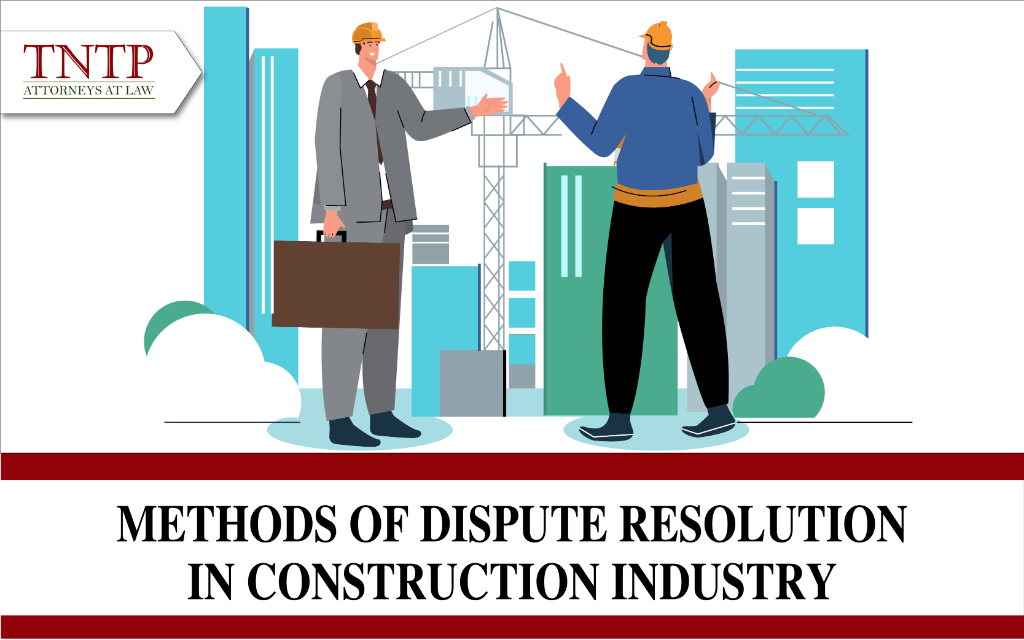Dispute in the construction field is a contradiction or disagreement of one or both parties regarding the performance of rights and obligations in a construction contract. Typically, the disputes arise from the contract, the parties can resolve the dispute in the following ways: Negotiation, mediation, dispute resolution by commercial arbitration, or lawsuit in court. In this article, TNTP will analyze some characteristics of these dispute resolution methods.
1. Resolve disputes in the construction field by negotiation
Negotiation is one of the methods of resolving disputes through which the disputing parties will come together to contact, learn, negotiate, and make concessions to resolve arising disagreements without the assistance or judgment of any third party.
Among dispute resolution methods, negotiation is the first method applied in the dispute resolution process and is also the most popular and effective method today.
Accordingly, when a dispute occurs, one of the disputing parties can suggest that the parties meet to discuss directly or negotiate indirectly through methods such as email, phone conversation, or via the Zoom platform, etc…to agree and resolve disputes. This dispute resolution is flexible, fast, and economical for the parties. However, whether or not negotiations are successful depends on the goodwill of the parties.
2. Resolve disputes in the construction field through mediation
In case negotiations are unsuccessful, the parties can use mediation to resolve the dispute. Mediation is a method of dispute resolution agreed upon by the parties and has mediators to assist the parties in resolving the dispute. Thus, with this method, the presence of a mediator is mandatory.
To apply mediation, the parties must agree to choose a third party to mediate. The advantage of this method is that it is quick and saves time for the parties if the mediation is successful. If the mediation results are unsuccessful, this is a disadvantage of this method because the parties still have to pay a fee to the mediator. In addition, a prolonged conciliation period may affect the parties’ right to sue due to the expiration of the statute of limitations.
3. Resolve disputes in the construction field by commercial arbitration
Commercial arbitration is a method of dispute resolution agreed upon by the parties and conducted in accordance with the provisions of the Law on Commercial Arbitration 2010 and other relevant legal documents.
The dispute shall be settled by arbitration if the parties have an arbitration agreement. This agreement can be expressed in the form of (i) an arbitration clause agreed in the contract or the contract appendix; or (ii) a separate agreement, which may be made either before or after the dispute arises.
Typically, the parties will choose to resolve disputes at an arbitration center. After receiving the Petition, the Arbitration Center will establish an Arbitration Council to learn the case file, hold a meeting to resolve the dispute and issue the Arbitration Award. The arbitration award is final, cannot be appealed or protested, and must be enforced by the parties. Resolving disputes by Arbitration will save more time than resolving disputes in Court, and ensures that information is always kept confidential.
4. Resolve disputes in the construction field by Court
Resolving disputes by suing in Court is a traditional method, often chosen by parties. Dispute resolution by the Court is implemented in accordance with the provisions of the Civil Procedure Code 2015 and other relevant legal documents.
Before filing a lawsuit in Court, the plaintiff shall determine that the Court has jurisdiction to resolve the dispute. After accepting the case, the Court will summon the litigants to work, opening the meetings for checking the handover of, access to, and disclosure of evidence and mediating. If mediation is successful, the Court will issue a Decision recognizing the parties’ agreement. In case mediation fails, the Court will decide to bring the case to trial and open a trial. Although the method of filing a lawsuit in Court is traditional and popular, it has the disadvantage that the settlement process is lengthy, causing the disputing parties to spend a lot of effort and money.
Therefore, when a dispute occurs, the parties can flexibly use the above dispute resolution methods to meet their wishes and requirements.
Above is the content of the article “Methods of dispute resolution in the construction industry”. We hope that the article is useful for those who are interested in this issue.
Sincerely,








